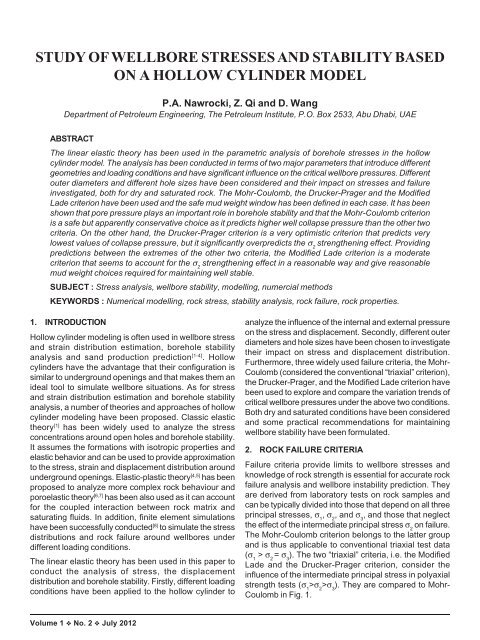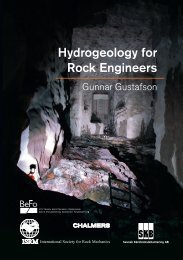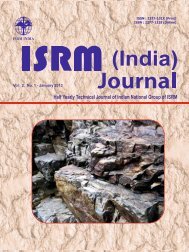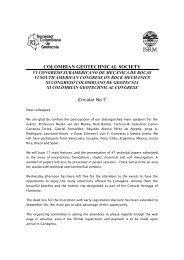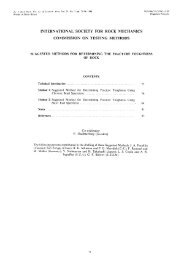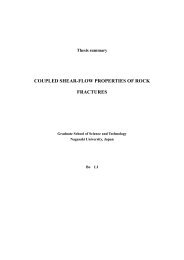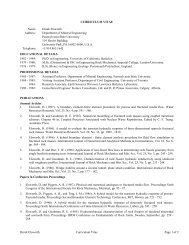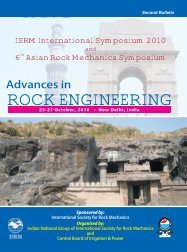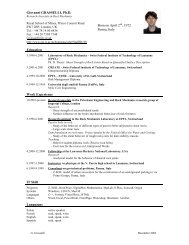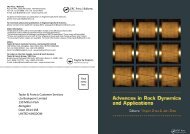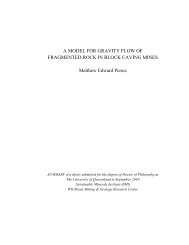ISSN : 2277-1328 (Online) - ISRM
ISSN : 2277-1328 (Online) - ISRM
ISSN : 2277-1328 (Online) - ISRM
Create successful ePaper yourself
Turn your PDF publications into a flip-book with our unique Google optimized e-Paper software.
10 <strong>ISRM</strong> (India) Journal<br />
STUDY OF WELLBORE STRESSES AND STABILITY BASED<br />
ON A HOLLOW CYLINDER MODEL<br />
P.A. Nawrocki, Z. Qi and D. Wang<br />
Department of Petroleum Engineering, The Petroleum Institute, P.O. Box 2533, Abu Dhabi, UAE<br />
ABSTRACT<br />
The linear elastic theory has been used in the parametric analysis of borehole stresses in the hollow<br />
cylinder model. The analysis has been conducted in terms of two major parameters that introduce different<br />
geometries and loading conditions and have significant influence on the critical wellbore pressures. Different<br />
outer diameters and different hole sizes have been considered and their impact on stresses and failure<br />
investigated, both for dry and saturated rock. The Mohr-Coulomb, the Drucker-Prager and the Modified<br />
Lade criterion have been used and the safe mud weight window has been defined in each case. It has been<br />
shown that pore pressure plays an important role in borehole stability and that the Mohr-Coulomb criterion<br />
is a safe but apparently conservative choice as it predicts higher well collapse pressure than the other two<br />
criteria. On the other hand, the Drucker-Prager criterion is a very optimistic criterion that predicts very<br />
lowest values of collapse pressure, but it significantly overpredicts the σ 2<br />
strengthening effect. Providing<br />
predictions between the extremes of the other two criteria, the Modified Lade criterion is a moderate<br />
criterion that seems to account for the σ 2<br />
strengthening effect in a reasonable way and give reasonable<br />
mud weight choices required for maintaining well stable.<br />
SUBJECT : Stress analysis, wellbore stability, modelling, numercial methods<br />
KEYWORDS : Numerical modelling, rock stress, stability analysis, rock failure, rock properties.<br />
1. INTRODUCTION<br />
Hollow cylinder modeling is often used in wellbore stress<br />
and strain distribution estimation, borehole stability<br />
analysis and sand production prediction [1-4] . Hollow<br />
cylinders have the advantage that their configuration is<br />
similar to underground openings and that makes them an<br />
ideal tool to simulate wellbore situations. As for stress<br />
and strain distribution estimation and borehole stability<br />
analysis, a number of theories and approaches of hollow<br />
cylinder modeling have been proposed. Classic elastic<br />
theory [1] has been widely used to analyze the stress<br />
concentrations around open holes and borehole stability.<br />
It assumes the formations with isotropic properties and<br />
elastic behavior and can be used to provide approximation<br />
to the stress, strain and displacement distribution around<br />
underground openings. Elastic-plastic theory [4,5] has been<br />
proposed to analyze more complex rock behaviour and<br />
poroelastic theory [6,7] has been also used as it can account<br />
for the coupled interaction between rock matrix and<br />
saturating fluids. In addition, finite element simulations<br />
have been successfully conducted [8] to simulate the stress<br />
distributions and rock failure around wellbores under<br />
different loading conditions.<br />
The linear elastic theory has been used in this paper to<br />
conduct the analysis of stress, the displacement<br />
distribution and borehole stability. Firstly, different loading<br />
conditions have been applied to the hollow cylinder to<br />
analyze the influence of the internal and external pressure<br />
on the stress and displacement. Secondly, different outer<br />
diameters and hole sizes have been chosen to investigate<br />
their impact on stress and displacement distribution.<br />
Furthermore, three widely used failure criteria, the Mohr-<br />
Coulomb (considered the conventional “triaxial” criterion),<br />
the Drucker-Prager, and the Modified Lade criterion have<br />
been used to explore and compare the variation trends of<br />
critical wellbore pressures under the above two conditions.<br />
Both dry and saturated conditions have been considered<br />
and some practical recommendations for maintaining<br />
wellbore stability have been formulated.<br />
2. ROCK FAILURE CRITERIA<br />
Failure criteria provide limits to wellbore stresses and<br />
knowledge of rock strength is essential for accurate rock<br />
failure analysis and wellbore instability prediction. They<br />
are derived from laboratory tests on rock samples and<br />
can be typically divided into those that depend on all three<br />
principal stresses, σ 1<br />
, σ 2<br />
, and σ 3<br />
, and those that neglect<br />
the effect of the intermediate principal stress σ 2<br />
on failure.<br />
The Mohr-Coulomb criterion belongs to the latter group<br />
and is thus applicable to conventional triaxial test data<br />
(σ 1<br />
> σ 2<br />
= σ 3<br />
). The two “triaxial” criteria, i.e. the Modified<br />
Lade and the Drucker-Prager criterion, consider the<br />
influence of the intermediate principal stress in polyaxial<br />
strength tests (σ 1<br />
>σ 2<br />
>σ 3<br />
). They are compared to Mohr-<br />
Coulomb in Fig. 1.<br />
Volume 1 No. 2 July 2012


